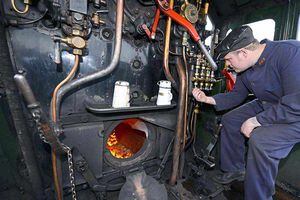Severn Valley Railway driver talks role - with video
It's an iconic British image – the sight of a steam locomotive moving majestically through the countryside to the shrill of a whistle echoing along the tracks.

For railway enthusiast Gary Williams standing on the footplate is in his blood. He unwittingly began following in his grandfather's footsteps when he began volunteering at the Severn Valley Railway at only 10-years-old of age.
Now 19 years after first enrolling on its junior apprentice scheme, he's a volunteer driver, having worked his way up from the bottom rung of the ladder.
When he's not winding his way through the picturesque Shropshire and Worcestershire countryside, the 29-year-old works at the heritage line's workshop at Bridgnorth Station where staff carry out running repairs on all of the locomotives.
The steam railway has been part of Britain's heritage for 200 years and Gary wants to see it preserved for generations to come.
See the video here:
"It's a labour of love. It's keeping a bit of British history alive. The railways are an important part of our past and it's very important to me that we keep this tradition going for years to come.
"I only found out recently that my granddad, Joseph Cavanagh, worked on steam engines in Birmingham so it's nice that I've ended up doing the same thing that he did," explains Gary.
He got his first taste of life on the railway in the apprentices club, which gives young enthusiasts the chance to work on supervised maintenance projects.
Gary enjoyed it so much that he has been a volunteer ever since and is one of the longest-serving on the books.
When he was 14, he started working as an engine cleaner before later becoming a fireman and two and a half years ago, the coveted role of driver, which he says is a dream job.
It requires plenty of time, dedication and the ambition to learn the necessary skills for this much-sought after position.
Training for footplate work as a fireman then driver takes many years and is judged by attendance, attitude and expertise.
Everyone has to start by cleaning both locomotives and around the sheds, which might include clearing inspections pits and disposing of the ash.
After learning the ropes they'll then move on to fire lighting and will continue to work their way up the ladder to becoming a driver.
Footplate work also requires a volunteer to attend a training course, which is followed by an examination and a medical to ensure they have the necessary skills and fitness.
Wannabe drivers are expected to bide their time until a rare vacancy becomes available because once people are in the role, they rarely leave.
"In this business, it's called 'filling dead man's shoes'. On the railway, you spend years learning the trade and moving up the ranks until one day a position becomes available.
"It's how it has always worked in British railways," says Gary, who lives at one end of the 16-mile line, which closely follows the meandering course of the River Severn, in Bridgnorth.
He is one of 1,700 volunteers who help staff to keep the railway running, which includes the several hundred drivers that are needed to keep the busy train timetables on track throughout the year.
They cover a large variety of vital roles from operating the train service, staffing the stations along the route and carrying out maintenance work on the line and engines through to support activities such as marketing, telephone answering, assisting in shops and gardening.
Alongside his role in the workshop, Gary volunteers to step inside the cab around twice a fortnight along with a fireman, who tends to the fire to keep the engine running.
Although sometimes there's no such thing as a typical day with varying timetables, engines and weather all playing a part, there are a few things that every shift as a driver has in common.
Passenger safety and comfort is always top of the daily list of priorities. "We are always watching the line and keeping an eye on everything to make sure it's all working correctly while also making sure everyone is having a nice, comfortable ride," explains Gary.
But there are some challenges that come with the driver's job especially when our unpredictable British weather means you can't always count on the sun to shine.
"In bad weather, when it's raining or it's cold outside, you are exposed to the elements because the cab is open so it can get cold and wet.
"When it is very cold, it can also be icy and this means it will be harder to control the engine on the rails because it's steel on steel, there are no tyres so you have to be more careful to keep it on the rails," says Gary, who was part of the team invited to Buckingham Palace in 2013 when the railway's hard-working band of volunteers were presented with the prestigious Queen's Award for Voluntary Service.
When asked what he enjoyed most about being a volunteer steam train driver, Gary says he liked playing a part in helping passengers to have a memorable journey.
"Seeing the enjoyment on people's faces is wonderful. It's also special because of my grandad doing it as his job. It's nice to have that family link.
"It's something that I've wanted to do for a long time so it's exciting that I'm now able to do it.
"The railway is such as important part of our British history, it's nice to be playing a part in keeping it alive."
The railway is always keen to hear from people interested in volunteering, whether it's a few days each year or on a more regular basis, and full training will be given where required.
To find out more about how to get involved see www.svr.co.uk where information on the railway's Share Offer to help raise £2.5million to revamp Bridgnorth Station is also available.
To see Gary at work on the Severn Valley Railway see www.expressandstar.com
By Heather Large





